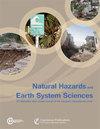通过基于协程的强度-持续时间-频率曲线探测山洪:牙买加的证据
IF 4.2
2区 地球科学
Q1 GEOSCIENCES, MULTIDISCIPLINARY
引用次数: 0
摘要
摘要在世界许多地区,极端降雨事件经常引发危险的洪水。随着人类遭受洪灾的风险越来越大,研究引发洪灾的条件势在必行。山洪爆发尤其需要定义明确的模型,以便及时向处于危险中的人群发出警告。强度-持续时间-频率(IDF)曲线是描述降雨和洪水事件特征的常用方法。在此,我们采用 copula 方法来灵活地模拟降雨事件的强度和持续时间之间的依赖关系,并将其与各自的边际分布分开。我们收集了牙买加 93 次山洪暴发的定位信息,并将其与遥感降雨量数据联系起来,还构建了特定地点年最大降雨量事件的附加数据。估算出的正态共轭曲线在持续时间和强度方面分别具有 Weibull 和广义极值(GEV)边际。有了这两个样本,就可以确定降雨事件在强度持续时间空间的哪条线以上可能引发山洪。与 216 年重现期相关的 IDF 参数曲线被确定为山洪事件分类的最佳阈值。该方法提供了生成降雨 IDF 曲线的灵活方法,可直接用于评估山洪风险。本文章由计算机程序翻译,如有差异,请以英文原文为准。
Flash flood detection via copula-based intensity–duration–frequency curves: evidence from Jamaica
Abstract. Extreme rainfall events frequently cause hazardous floods in many parts of the world. With growing human exposure to floods, studying conditions that trigger floods is imperative. Flash floods, in particular, require well-defined models for the timely warning of the population at risk. Intensity–duration–frequency (IDF) curves are a common way to characterize rainfall and flood events. Here, the copula method is employed to model the dependence between the intensity and duration of rainfall events flexibly and separately from their respective marginal distribution. Information about the localization of 93 flash floods in Jamaica was gathered and linked to remote-sensing rainfall data, and additional data on location-specific yearly maximum rainfall events were constructed. The estimated normal copula has Weibull and generalized extreme value (GEV) marginals for duration and intensity, respectively. Due to the two samples, it is possible to pin down above which line in the intensity duration space a rainfall event likely triggers a flash flood. The parametric IDF curve with an associated return period of 216 years is determined as the optimal threshold for flash flood event classification. This methodology delivers a flexible approach to generating rainfall IDF curves that can directly be used to assess flash flood risk.
求助全文
通过发布文献求助,成功后即可免费获取论文全文。
去求助
来源期刊
CiteScore
7.60
自引率
6.50%
发文量
192
审稿时长
3.8 months
期刊介绍:
Natural Hazards and Earth System Sciences (NHESS) is an interdisciplinary and international journal dedicated to the public discussion and open-access publication of high-quality studies and original research on natural hazards and their consequences. Embracing a holistic Earth system science approach, NHESS serves a wide and diverse community of research scientists, practitioners, and decision makers concerned with detection of natural hazards, monitoring and modelling, vulnerability and risk assessment, and the design and implementation of mitigation and adaptation strategies, including economical, societal, and educational aspects.

 求助内容:
求助内容: 应助结果提醒方式:
应助结果提醒方式:


